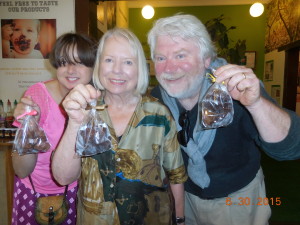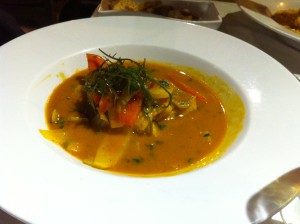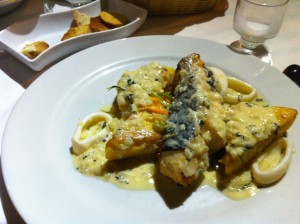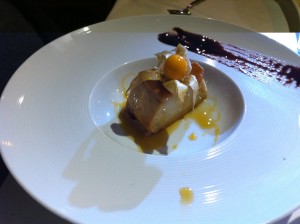This blog will take you to places you’ve always wanted to see and to some you may only have heard of. Its purpose – to immerse you in extraordinary tastes and colors, smells, sights and experiences, infecting you, or perhaps aggravating, an already serious case of wanderlust.
Many thanks for visiting Foreign Writes. Your comments are always welcome. Hope you’ll be back soon!
To view comments or to leave one, please click on the title of the post. Click on photos to enlarge.
Peru – Lima – On to the Amazon!
 Our days and evenings in Lima are full. We taxi to Barranco, an arty resort area south of Mirraflores, to see a stunning collection of Peruvian art dating to the 16th
Our days and evenings in Lima are full. We taxi to Barranco, an arty resort area south of Mirraflores, to see a stunning collection of Peruvian art dating to the 16th 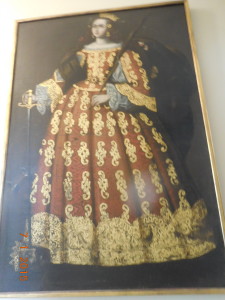 century at the Pedro di Osma museum – paintings, sculpture and loads of over-the-top silver – displayed in the family villa.
century at the Pedro di Osma museum – paintings, sculpture and loads of over-the-top silver – displayed in the family villa.
We savor our choices at Pescados Capitales – a twist on the Spanish for mortal sins (pecados capitales) – eating more meltingly tender octopus and freshest fish. (Have a look at their menu at pescadoscapitales.com)
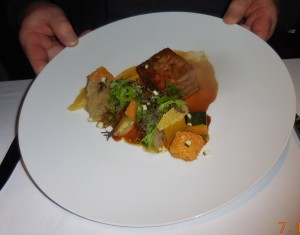 We enjoy the wood-paneled intimacy of Malabar, home to another of Lima’s famous chefs –
We enjoy the wood-paneled intimacy of Malabar, home to another of Lima’s famous chefs – 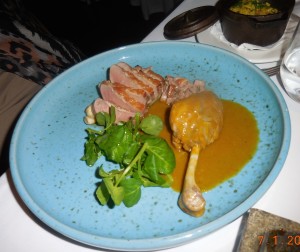 Pedro Miguel Schiaffino – whose passion is creating dishes using ingredients from the Amazon.
Pedro Miguel Schiaffino – whose passion is creating dishes using ingredients from the Amazon.
We admire central Lima’s plazas and grand colonial architecture, and we visit Casa Aliaga, across from the presidential palace, built on land given in 1535 to Jerome de Aliaga, a Spanish pig farmer who became Pizarro’s 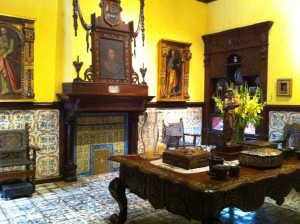 treasurer in the newly conquered territory. It is still occupied by his descendants – 78 rooms, 22 bedrooms. Exquisite.
treasurer in the newly conquered territory. It is still occupied by his descendants – 78 rooms, 22 bedrooms. Exquisite.
We meet the other 24 members of our ‘expedition’, our expedition leader and our National Geographic photographer. Our bags are checked, our plane tickets in hand.
Next stop Iquitos and the AMAZON!!!
Peru – Lima – Traces of Early Glory
Once upon a time the desert that is now Lima’s central Pacific coast, with 1/2″ of rain per year, was a thriving agricultural area with wetlands, forests and extensive fruit tree plantings watered by a complex irrigation system. The sea and all its wealth was there for the taking. No wonder the culture, now referred to as Lima (200-700 a.d.), thrived. Here they built Maranga, a city with 14 giant pyramids and 50 smaller public buildings spread over 4,000,000 square meters. Most of those marvels have been lost over the last two centuries as Lima expanded. The only major site remaining is a religious and administrative center known as Huaca Pucllana. Pucllana comes from the Quechua word meaning a site for games – in this case sacred games. Here the Lima people worshipped female goddesses representing the moon and the sea.
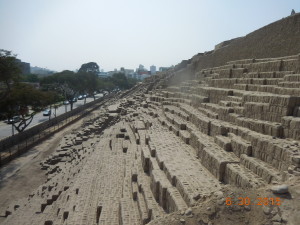 Now surrounded by the up-market neighborhood of Milleflores, the six acre site is being excavated and restored. The huge central pyramid, 22 meters high, 500 meters long, 100 meters wide, rises in 7 levels, ascended by zigzag ramps. The genius of its builders is evident – after 1500 years it still stands in this land of horrendous
Now surrounded by the up-market neighborhood of Milleflores, the six acre site is being excavated and restored. The huge central pyramid, 22 meters high, 500 meters long, 100 meters wide, rises in 7 levels, ascended by zigzag ramps. The genius of its builders is evident – after 1500 years it still stands in this land of horrendous 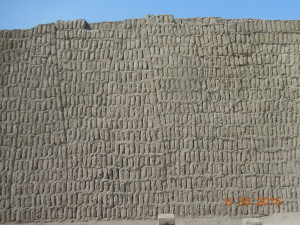 earthquakes. It was built using the “bookshelf” technique – placing small rectangular adobe bricks (6 million of them) vertically leaving a space between, and putting plaster only on the upper and lower parts. This provided enough give to absorb centuries of shocks.
earthquakes. It was built using the “bookshelf” technique – placing small rectangular adobe bricks (6 million of them) vertically leaving a space between, and putting plaster only on the upper and lower parts. This provided enough give to absorb centuries of shocks.
The whole pyramid was once plastered and painted a pale yellow in honor of the moon goddess. Here priests presided over rituals including the sacrifice of young women.
 In about 700, the Lima people succumbed to the warlike Hwari who turned the top level of the pyramid into a burial site for their elites. Sixty five graves have been found so far, the mummies often accompanied by sacrificed victims as in this burial – two small children.
In about 700, the Lima people succumbed to the warlike Hwari who turned the top level of the pyramid into a burial site for their elites. Sixty five graves have been found so far, the mummies often accompanied by sacrificed victims as in this burial – two small children.
The area was part of the Inca empire from 1450 until the Spanish conquest in 1535 when the indigenous population was relegated to peripheral villages, and Lima, then known as Las Reyes, became the conquerers capital.
After climbing up and down Huaca Pucllana, we are more than ready to relax at La Gloria that evening. Check out the mouthwatering photos on their website – www.lagloriarestaurant.com
Peru – Lima – World Class Eating
Three chefs are igniting the culinary explosion that makes Lima the gastronomic capital of Latin America, with 4 spots on this year’s list of the world’s top 50 restaurants. Astrid y Gaston, one of Gaston Acurio’s numerous restaurants, holds down one of those spots with its 17 course tasting menu. Trained at Cordon Bleu, Paris, Acurio is a champion of ‘cocina novoandina’, new Andean cuisine, seeking out traditional ingredients, from jungle forest to altiplano, putting them together borrowing ideas from Peru’s cultural influences – indigenous, Spanish, Italian, Chinese, Japanese. The result is a wonderful palate of new tastes. Acurio’s cooking school, in a scruffy part of Lima, is training the next generations of innovators with 450 applicants for its annual intake of 25 students.
Every restaurant we eat at has menus in English, but we’re never quite sure what we’ll be served. The unique local fish, fruits, herbs and vegetables (including 3,500 types of potatoes and 29 different kinds of corn) don’t translate – fruits like lucama, chirimoya, pepina, camu camu, tumbo. Fish with names like caballa, cabrilla, chita, mero, lenguado, among many others. Ordering is an adventure.
 We’re in the mood for something more casual than the Astrid Y Gaston three hour experience, and reserve at La Barra de la Moreyra, his open kitchen dining room. The ceiling is hung with air plants from
We’re in the mood for something more casual than the Astrid Y Gaston three hour experience, and reserve at La Barra de la Moreyra, his open kitchen dining room. The ceiling is hung with air plants from  the Amazon, the menu changing to reflect what’s in the markets and his garden.
the Amazon, the menu changing to reflect what’s in the markets and his garden.
Our server warns us that main course portions are meant to be shared and we order the herb crusted roast of pork for the three of us. It will take 50 minutes to cook and we 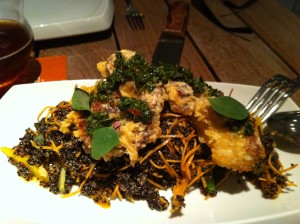 foolishly order three starters – black quinoa with octopus, cannelloni made with strips of zucchini instead of past
foolishly order three starters – black quinoa with octopus, cannelloni made with strips of zucchini instead of past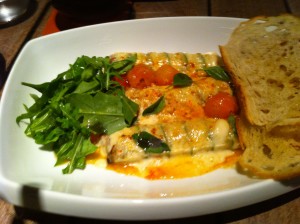 a, and sea mushrooms.
a, and sea mushrooms.
Unfortunately, the warm breads are also delicious.
Our mouths fall open when the pork roast arrives – stunning and HUGE. Sliced into four 2″ thick rosy pink pieces, it is glorious, fork tender, juicy perfection. But even Mark’s outsize appetite is no match, and, to his very real dismay, one slice goes back to the kitchen. He will have bad  dreams about this more than once.
dreams about this more than once.
Did I mention that restaurant checks in Lima are about 1/3 the bill at a comparable place in the U.S.?
Indulge!
For more on Acurio – www.astridygaston.com
Peru – Lima – All About Chocolate
We sign up for the Museum of Chocolate’s two hour workshop. It takes us from an introduction to the cocoa bean to producing our own hot chocolate, and molding and flavoring our own chocolates.
Our very cute and enthusiastic instructor, Malvina, hands us foot- long cocoa pods. When ripe, the beans are embedded in a sweet white gelatin, yummy to the creatures who eat the contents of the pods and spread its seeds. Jungle farmers split the pods and dry them for four days in the sun while the beans absorb the sweet coating. On the forest floor, the thick carpet of cocoa leaves holds in moisture and adds nutrients as the leaves decay.
Emma stirs the beans as they roast in a 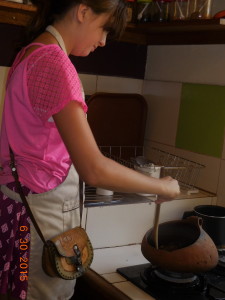 terra cotta pot, and the aroma of chocolate makes our mouths water. Roasting is responsible for the chocolate flavor we love.
terra cotta pot, and the aroma of chocolate makes our mouths water. Roasting is responsible for the chocolate flavor we love.
It’s time for the hard work. Malvina equips us with mortars and pestles and tells us to grind the shelled beans into a paste. Easier  said than done. The museum has machines to do the grinding. After sugar is added, other machines stir the paste for 24 hours to produce a glossy finish.
said than done. The museum has machines to do the grinding. After sugar is added, other machines stir the paste for 24 hours to produce a glossy finish.
Eventually we produce something that resembles paste and it’s time to make Inca hot chocolate. We mix hot water, our cocoa paste, a bit of honey, chili pepper flakes and a dash of paprika to simulate human blood. (Hot chocolate, was drunk by Inca rulers as part of human sacrifice ceremonies.) We pour the ingredients back and forth to mix them. The result is not delicious.
Our next recipe is much tastier – hot milk, our cocoa paste, sugar, cloves and cinnamon – the way Peruvians drink their hot chocolate today. MUCH better.
It’s time to choose molds from trays and trays of shapes, and decide whether 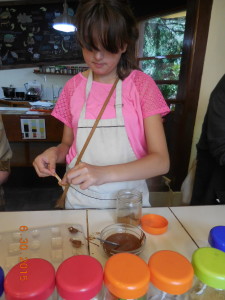 we want to make dark or milk chocolate candies using the museum’s stirred and sweetened chocolate . Our instructor sets out everything from sea salt to gummy bears – 15 possibilities to add to our candies. Emma decides to use them all.
we want to make dark or milk chocolate candies using the museum’s stirred and sweetened chocolate . Our instructor sets out everything from sea salt to gummy bears – 15 possibilities to add to our candies. Emma decides to use them all.
After a little refrigeration our masterpieces are ready. They don’t last long!
Peru – Lima – Adventures Begin
Such a relief to get off the plane! Such a relief to find the driver waiting when I wheel my heavy bag out of customs. He is more than waiting, he is calling “Sharon Dembro, Sharon Dembro.” It is after midnight by the time he deposits me at our hotel and I’m reunited with husband Mark and granddaughter Emma, who arrived earlier from NYC.
Our joint travel fatigue means we don’t wake up till nearly 11 the next morning, nearly time for lunch. We taxi to El Pan de la Chola – a very cool bakery/cafe with stacks of freshly baked whole grain breads and pillowy focaccias. It’s filled with sleek Limenos and classic rock. The Burrata – fresh cheese, teeny tomatoes and fruity olive oil with grilled focaccia – hits the spot. We order one each of the freshly made drinks in dazzling colors – orange, beet red and spinach green – perfect thirst quenchers.
We’re only a couple of blocks from the Pacific, so we decide to walk back. So beautiful. A continuous park – six miles long – follows the top of cliffs that drop off to the beach below, the steep sides covered in a parrot green vine. The surfers are out in droves, braving the waves below. We pass a skate board park, a bicycle course, dog parks and kiddie parks, while overhead, the para-sailors zoom along on the fresh ocean breeze. Everything is spotless, perfectly maintained, and planted with exotic trees and a rainbow of flowers.
Back at the hotel, Emma needs pool time and I sip my first Pisco Sour – the drink Lima is famous for – while I watch her. Yum! It’s clear it won’t be my last.
I’ve made dinner reservations for each of our nights in Lima, home to 5 of the world’s top 50 restaurants. The current exchange rate is very favorable. We head off to our first culinary adventure, only to find La Gloria CLOSED on Sunday! – not something I understood when I used my meager Spanish to make the reservation. Turns out few restaurants are open Sunday night.
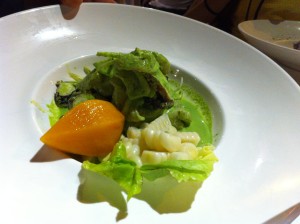 The hotel concierge calls around with no luck. Finally he recommends a nearby fish restaurant, Al Fresco. It turns out to be WONDERFUL! It’s hard to choose from a menu full of temptations, but Mark settles on a ceviche of octopus, fish and squid in a cilantro sauce.
The hotel concierge calls around with no luck. Finally he recommends a nearby fish restaurant, Al Fresco. It turns out to be WONDERFUL! It’s hard to choose from a menu full of temptations, but Mark settles on a ceviche of octopus, fish and squid in a cilantro sauce.
Emma and I choose octopus in olive sauce – the octopus barely needs chewing 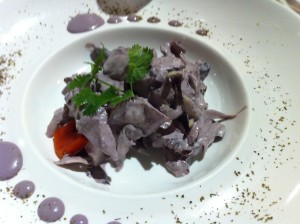 and the creamy olive sauce gives just the right amount of zing.
and the creamy olive sauce gives just the right amount of zing.
Mark orders the fish soup – the broth the essence of fish.
Emma can’t resist the shrimp 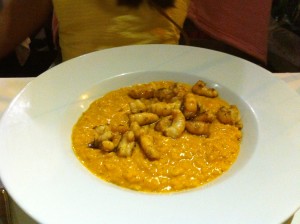 risotto.
risotto.
I order Raballo (a halibut- like fish) in a sauce of sauvignon blanc with octopus rings and a fluffy polenta cake.
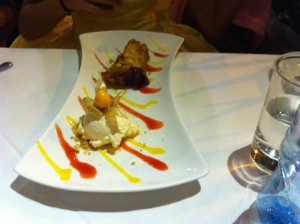 Emma loves her apple crumble with vanilla ice cream.
Emma loves her apple crumble with vanilla ice cream.
Here’s my Lucuma (a yummy fruit) Bavarois.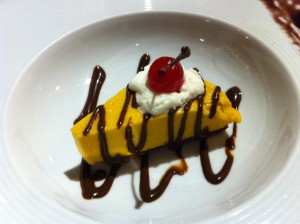
We agree Al Fresco would hold its own in Italy – and that’s saying a lot!



